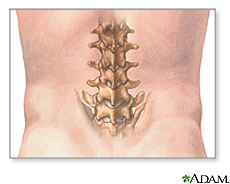 |
 |
 |
Other Health Topics:

-
Related Topics
-
Go Local
- Services and providers for Herniated Disk in the U.S.
-
National Institutes of Health
- The primary NIH organization for research on Herniated Disk is the National Institute of Arthritis and Musculoskeletal and Skin Diseases
Herniated Disk
Also called: Bulging disk, Compressed disk, Herniated intervertebral disk, Herniated nucleus pulposus, Prolapsed disk, Ruptured disk, Slipped disk
Your backbone, or spine, is made up of 26 bones called vertebrae. In between them are soft disks filled with a jelly-like substance. These disks cushion the vertebrae and keep them in place. A herniated disk is a disk that slips out of place or ruptures. If it presses on a nerve, it can cause back pain or sciatica.
Symptoms include
- Back pain that spreads to the buttocks and legs, when the herniated disk is in your lower back
- Neck pain that spreads to the shoulders and upper arms, when the herniated disk is in your upper back
- Tingling or numbness
- Muscle spasms or weakness
With treatment, most people recover. It can take a long time. Treatments include rest, pain and anti-inflammatory medicines, physical therapy and sometimes surgery. Losing weight can help, too.
Start Here
- Herniated Disc(American Association of Neurological Surgeons)
-
Herniated Disk: What It Is and What You Can Do(American Academy of Family Physicians)
Also available in Spanish
| Basics | Learn More | Multimedia & Cool Tools |
|---|---|---|
| Research | Reference Shelf | For You |
|
-
Overviews
- Herniated Disk Guide(Mayo Foundation for Medical Education and Research)
-
Diagnosis/Symptoms
- Discography(North American Spine Society) - Links to PDF
-
MRI of the Spine(American College of Radiology, Radiological Society of North America)
Also available in Spanish
- Spine X-Ray(Cleveland Clinic Foundation)
-
Treatment
- Artificial Discs(North American Spine Society) - Links to PDF
- Epidural Injections(American College of Radiology, Radiological Society of North America)
- Laminectomy or Laminotomy(North American Spine Society)
- Laparoscopic Spine Surgery(Society of American Gastrointestinal Endoscopic Surgeons)
- Open Discectomy(North American Spine Society) - Links to PDF
- Spinal Fusion(American Academy of Orthopaedic Surgeons)
- Spinal Injections(North American Spine Society) - Links to PDF
-
Alternative Therapy
- Prolotherapy(InteliHealth)
-
Specific Conditions
- Cauda Equina Syndrome(American Association of Neurological Surgeons)
- Cervical Radiculopathy(American Academy of Orthopaedic Surgeons)
- Cervical Spine(American Association of Neurological Surgeons)
- Cervical Spondylosis(Mayo Foundation for Medical Education and Research)
- Herniated Cervical Disc(North American Spine Society) - Links to PDF
- Herniated Lumbar Disc(North American Spine Society) - Links to PDF
-
JAMA Patient Page: Herniated Lumbar Disks(American Medical Association)
Also available in Spanish
-
Videos
- Anterior Cervical Fusion(OR-Live) - Requires media player - One hour program
- Extreme Lateral Interbody Fusion Procedure(OR-Live) - Requires Flash Player - One hour program - 5/14/2008
- Minimally Invasive Discectomy(OR-Live) - Requires media player - One hour program - 6/16/2006
- Minimally Invasive Spine Surgery for Herniated Lumbar Discs(OR-Live) - Requires Flash Player - One hour program - 02/22/2008
- Minimally Invasive Transforaminal Lumbar Interbody Fusion(OR-Live) - Requires media player - One hour program - 12/05/2006
- PEEK Rod System for Transforaminal Lumbar Interbody Fusion(OR-Live) - Requires media player - One hour program - 6/12/2007
- Spinal Microdiscectomy(OR-Live) - Requires Flash Player - One hour program - 5/13/2008
-
Anatomy/Physiology
- Anatomy of the Spine(National Pain Foundation)
-
Clinical Trials
-
ClinicalTrials.gov: Intervertebral Disk Displacement
 (National Institutes of Health)
(National Institutes of Health)
-
ClinicalTrials.gov: Intervertebral Disk Displacement
-
Research
-
Study Shows Patients with Herniated Disks Improve over Time - Even without Surgery
 (National Institute of Arthritis and Musculoskeletal and Skin Diseases)
(National Institute of Arthritis and Musculoskeletal and Skin Diseases)
-
Study Shows Patients with Herniated Disks Improve over Time - Even without Surgery
-
Journal Articles
References and abstracts from MEDLINE/PubMed (National Library of Medicine)
- Article: Low back pain and sciatica: treatment with intradiscal-intraforaminal O(2)-O (3)...
- Article: Percutaneous endoscopic approach for highly migrated intracanal disc herniations by...
- Article: Management of sciatica due to lumbar disc herniation in the...
- Herniated Disk -- see more articles
-
Dictionaries/Glossaries
- Glossary of Terms(North American Spine Society)
-
Directories
- Spine Care Provider Search(North American Spine Society)
-
Organizations
-
National Institute of Arthritis and Musculoskeletal and Skin Diseases

Also available in Spanish
-
National Institute of Arthritis and Musculoskeletal and Skin Diseases
| Home | Health Topics | Drugs & Supplements | Encyclopedia | Dictionary | News | Directories | Other Resources | |
| Disclaimers | Copyright | Privacy | Accessibility | Quality Guidelines U.S. National Library of Medicine, 8600 Rockville Pike, Bethesda, MD 20894 National Institutes of Health | Department of Health & Human Services |
Date last updated: 14 September 2008 Topic last reviewed: 11 June 2008 |






